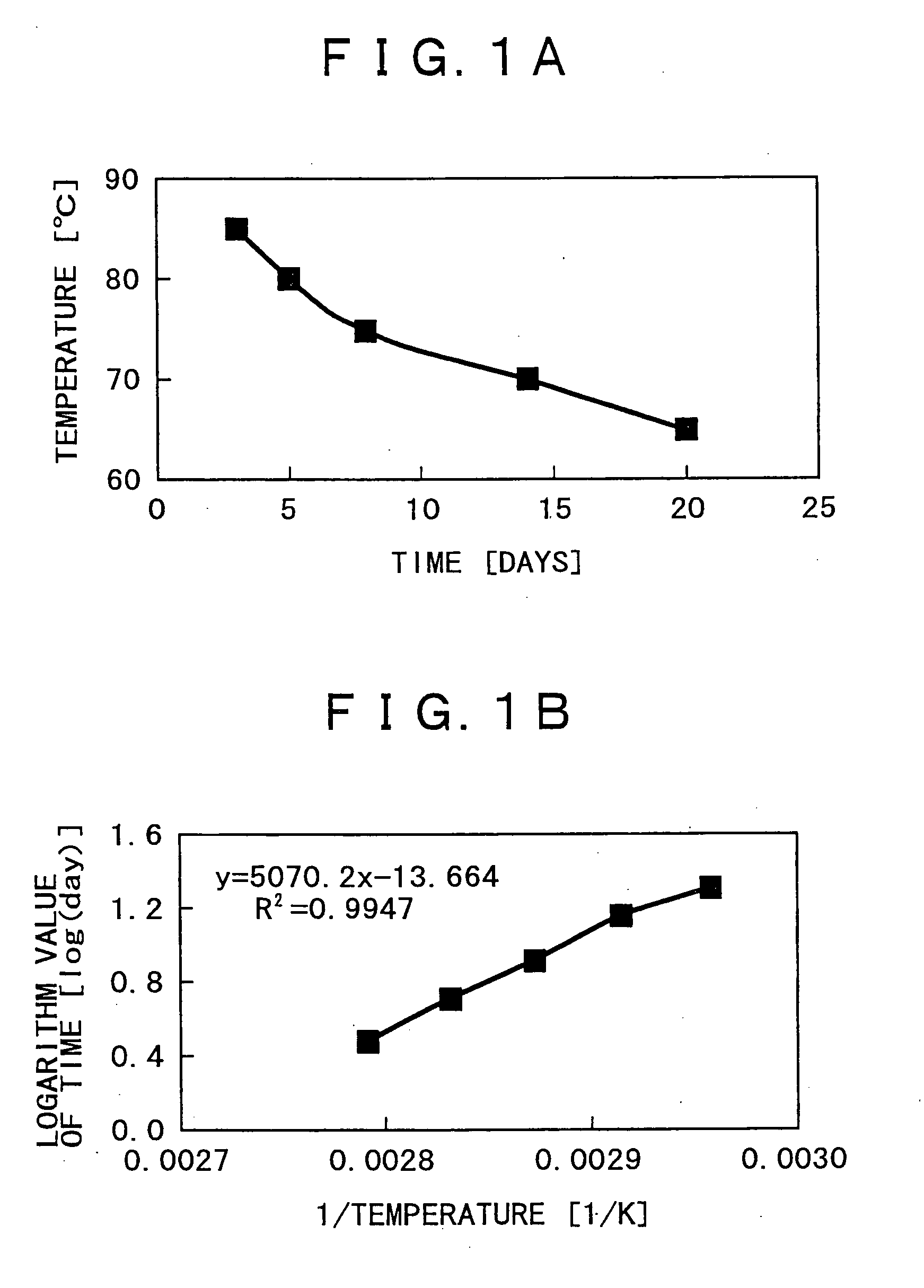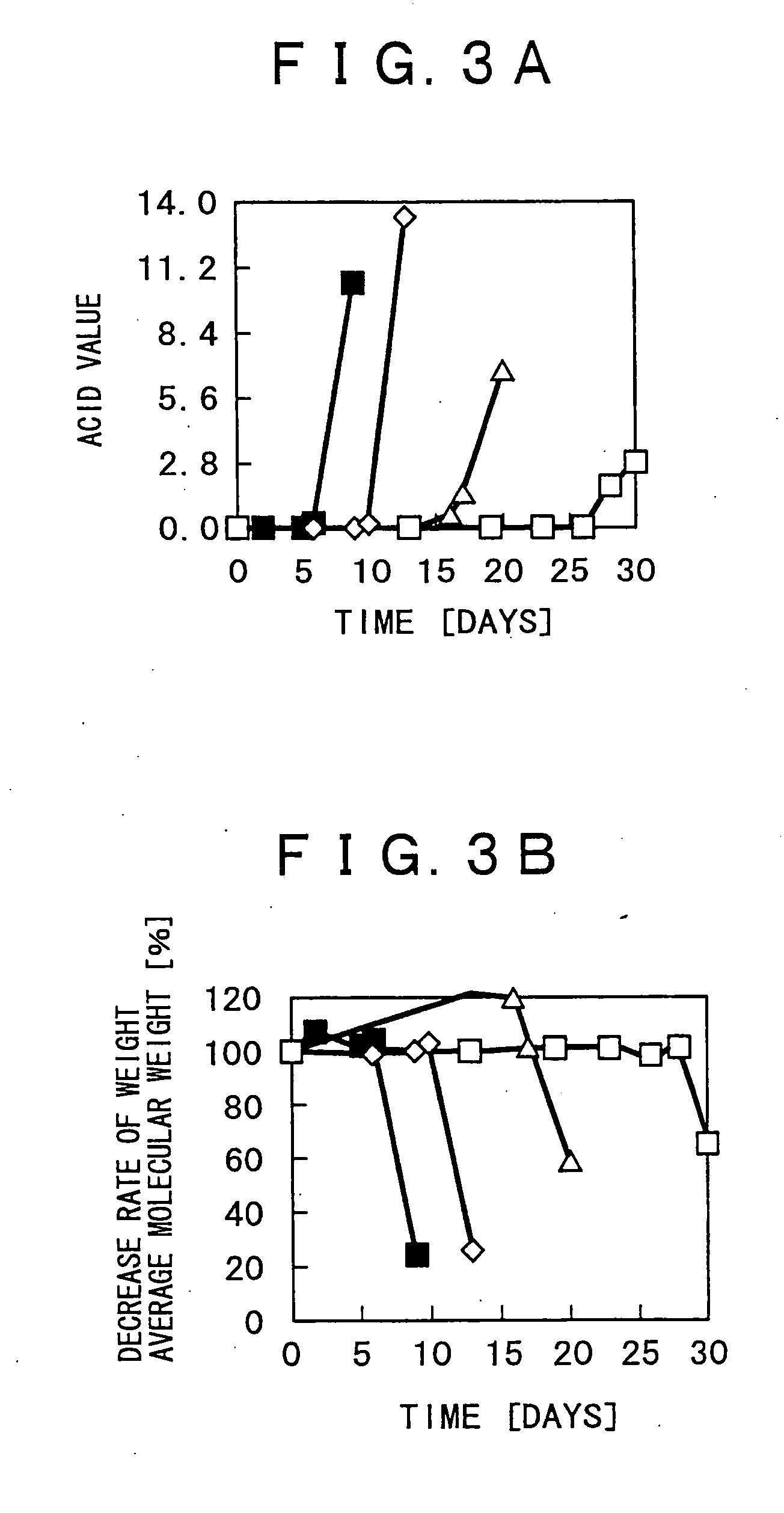Polyester molding for use with a casing
a polymer molding and plastic material technology, applied in the direction of mica, dyeing process, inorganic insulators, etc., can solve the problems of large amount of waste material, insufficient recycling of used electric appliances, and disruption of the global environment, so as to reduce the amount of active hydrogen, reduce the amount of residual fatty acids, and improve the effect of long-term reliability
- Summary
- Abstract
- Description
- Claims
- Application Information
AI Technical Summary
Benefits of technology
Problems solved by technology
Method used
Image
Examples
example 1
[0080]To polylactic acid (brand name: LACEA H100J, product of Mitsui Chemicals, Inc.) was added 1 weight % of carbodiimide (brand name: carbodilite 10B, product of Nisshinbo Industries, Inc.) as a compound reactive to active hydrogen, and the mixture was blended at a temperature of 185° C. for five minutes. The acid value fell from 1.8 to 0.1. The blended substance was molded into the shape of a square plate with sides measuring five centimeters each and a thickness of 1 mm, and it was then subjected to aging for 48 hours under a condition of 80° C. in temperature and 80% in humidity. The rise in acid value was 0.2 or less, and the decrease in molecular weight was 10% or less.
example 2
[0081]A sample piece was prepared in a manner similar to that of example 1, except that the amount of carbodiimide added was changed to 0.5 or 0.8 weight %, and the mixture was then blended. Upon the addition of 0.5 weight % or 0.8 weight % of carbodiimide, the acid value was 0.8 or 0.5, respectively. After being subjected to aging for 48 hours under a condition of 80° C. in temperature and 80% in humidity, the rise in acid value of the test sample to which 0.8 weight % of carbodiimide was added was 0.2 or less and the decrease in molecular weight was 10% or less. On the other hand, with the test sample to which 0.5 weight % of carbodiimide was added, the acid value increased from 0.8 to 5.2 in acid value and the molecular weight decreased by 60%.
example 3
[0082]To each of polycaprolactone (brand name: Cellgreen, Grade: PH, product of Daicel Chemical Industries, Ltd.) and polybutylene succinate (brand name: Bionolle #1000, product of Showa Highpolymer Co., Ltd.) was added 1 weight % of carbodiimide (brand name: Carbodilite 10B, product of Nisshinbo Industries, Inc.) to prepare test samples in a manner similar to that of the previously described example 1. The acid values of these test samples were respectively 0.4 and 0.2. Aging of these test samples was performed over 48 hours at 80° C. and 80% humidity, wherein the rise in acid value and the decrease in molecular weight were 0.2 or less and 10% or less, respectively, for both samples.
PUM
| Property | Measurement | Unit |
|---|---|---|
| diameter | aaaaa | aaaaa |
| humidity | aaaaa | aaaaa |
| temperature | aaaaa | aaaaa |
Abstract
Description
Claims
Application Information
 Login to View More
Login to View More - R&D
- Intellectual Property
- Life Sciences
- Materials
- Tech Scout
- Unparalleled Data Quality
- Higher Quality Content
- 60% Fewer Hallucinations
Browse by: Latest US Patents, China's latest patents, Technical Efficacy Thesaurus, Application Domain, Technology Topic, Popular Technical Reports.
© 2025 PatSnap. All rights reserved.Legal|Privacy policy|Modern Slavery Act Transparency Statement|Sitemap|About US| Contact US: help@patsnap.com



